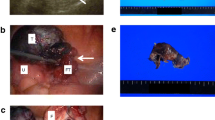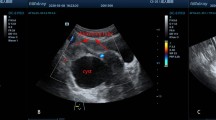Abstract
Background
Isolated fallopian tube torsion (IFTT) rarely occurs in pediatric patients and is difficult to diagnose preoperatively.
Objective
To determine the common sonographic and CT findings in girls with IFTT.
Materials and methods
We retrospectively reviewed the hospital charts and imaging studies of the eight girls diagnosed with and treated for IFTT at Columbus Children’s Hospital between January 1995 and June 2006 whose final diagnosis was IFTT.
Results
The mean age was 13 years with a range of 12 to 15 years. Two girls were premenarcheal. The most common presenting symptom was acute pelvic pain (n = 5). All patients were imaged. Six girls were imaged first with US, and the most common finding was a complex cystic pelvic mass in the midline (n = 5) and normal uterus and ovaries. Three of the eight girls had imaging with CT. In two girls, the torsed tube could be identified. In 63% of the girls, the uterus was deviated toward the side of torsion. The correct preoperative diagnosis was made in only one girl. None of the torsed fallopian tubes was salvaged at surgery. Pathological findings included ipsilateral adnexal cysts associated with the torsed tube (n = 7).
Conclusion
IFTT should be considered in the differential diagnosis for perimenarcheal girls who present with acute pelvic pain and who demonstrate a cystic mass in a midline position (either in the cul-de-sac or superior to the uterus) associated with a normal ipsilateral ovary.






Similar content being viewed by others
References
Orazi C, Inserra A, Lucchetti MC et al (2006) Isolated tubal torsion: a rare cause of pelvic pain at menarche. Sonographic and MR findings. Pediatr Radiol 36:1316–1318
Rizk DE, Lakshminarasimha B, Joshi S (2002) Torsion of the fallopian tube in an adolescent female. J Pediatr Adolesc Gynecol 15:159–161
Terada Y, Murakami T, Nakamura S et al (2004) Isolated torsion of the distal part of the fallopian tube in a premenarcheal 12 year old girl: a case report. Tohoku J Exp Med 202:239–243
Lineberry TD, Rodriguez H (2000) Isolated torsion of the fallopian tube in an adolescent. J Pediatr Adolesc Gynecol 13:135–137
Raziel A, Mordechai E, Friedler S et al (1999) Isolated recurrent torsion of the fallopian tube. Hum Reprod 14:3000–3001
Bondioni MP, McHugh K, Grazioli L (2002) Isolated fallopian tube torsion in an adolescent: CT features. Pediatr Radiol 32:612–613
Goktolga U, Ceyhan T, Ozturk H et al (2007) Isolated torsion of fallopian tube in a premenarcheal 12-year-old girl. J Obstet Gynaecol Res 33:215–217
Elchalal U, Caspi B, Schachter M et al (1993) Isolated tubal torsion: clinical and ultrasonographic correlation. J Ultrasound Med 2:115–117
Huang FJ, Chang SY, Lu YJ (1999) Laparoscopic treatment of isolated tubal torsion in a premenarcheal girl. J Am Assoc Gynecol Laparosc 6:209–211
Adekanmi OA, Barrington JW, Edwards G et al (2000) Isolated torsion and haemorrhagic infarction of a normal fallopian tube in an eleven year old girl. Br J Obstet Gynaecol 107:1047–1048
Jamieson MA, Soboleski D (2000) Isolated tubal torsion at menarche – a case report. J Pediatr Adolesc Gynecol 13:93–94
Ferrera PC, Kass LE, Verdile VP (1995) Torsion of the fallopian tube. Am J Emerg Med 13:312–314
Salamon C, Tornos C, Chi DS (2005) Borderline endometrioid tumor arising in a paratubal cyst: a case report. Gynecol Oncol 97:263–265
Dietrich JE, Heard MJ, Edwards C (2005) Uteroovarian ligament torsion of the due to a paratubal cyst. J Pediatr Adolesc Gynecol 18:125–127
Savelli L, Ghi T, De Iaco P et al (2006) Paraovarian/paratubal cysts: comparison of transvaginal sonographic and pathological findings to establish diagnostic criteria. Ultrasound Obstet Gynecol 28:330–334
Gross M, Blumstein SL, Chow LC (2005) Isolated fallopian tube torsion: a rare twist on a common theme. AJR 185:1590–1592
Author information
Authors and Affiliations
Corresponding author
Rights and permissions
About this article
Cite this article
Harmon, J.C., Binkovitz, L.A. & Binkovitz, L.E. Isolated fallopian tube torsion: sonographic and CT features. Pediatr Radiol 38, 175–179 (2008). https://doi.org/10.1007/s00247-007-0683-y
Received:
Revised:
Accepted:
Published:
Issue Date:
DOI: https://doi.org/10.1007/s00247-007-0683-y




